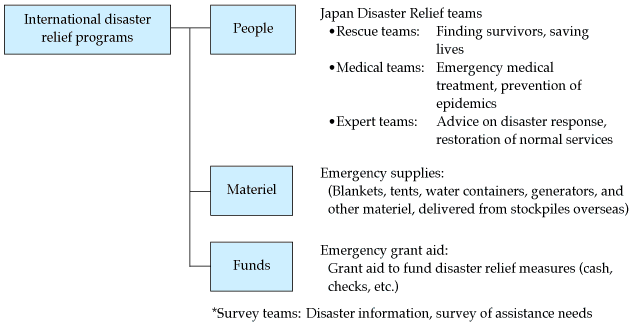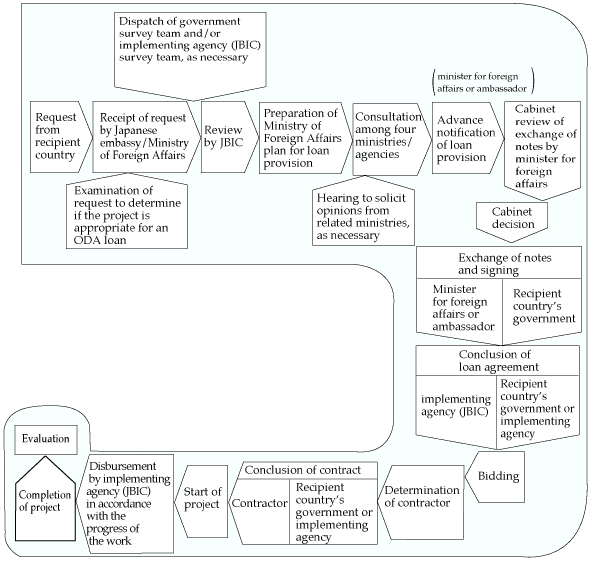Official Development Assistance (ODA)
Chapter 4 ODA Schemes
3. International Disaster Relief
The Japanese government has programs enabling relief teams, emergency supplies, and financial aid to be sent rapidly overseas upon request by a country where a major natural disaster or other calamity has struck. One of these programs offering humanitarian assistance to other countries is called Japan Disaster Relief Team. The rescue teams help to find victims and save lives; its medical teams administer emergency medical care; its expert teams give advice to officials of stricken countries regarding disaster response and reconstruction; Japan Self Defense Force units provide medical care, water purification and supply, transport, and other logistics. Any of these teams can be sent separately or in combination with others. There is also a survey team which can be dispatched after a disaster occurs and without waiting for a request from the country concerned to gather information on the disaster and assess assistance needs. Emergency supplies are provided whenever overseas disaster victims require them in an emergency; to enable materiel to reach victims as quickly as possible, Japan has emergency stockpiles overseas in four locations around the world (Singapore, Mexico, Washington D.C., and London) as well as in a JICA emergency supply depot which is located near Narita Airport in Japan to be deliverable from accessible air transport centers and as close as possible to where it might be needed. Financial grant aid is provided for a stricken country's government to carry out disaster relief (cf. Section 1 of this chapter, Grant Aid).

4.ODA Loans
(1) General overview
ODA loans (yen loans) extend funds for development for long periods at low interest to developing countries.
In providing these loans, Japan takes into consideration the stages of development which vary widely, from the LLDCs to "semi-developed" countries that are midway between developing and developed country status. Depending on the developing country's economic circumstances and creditworthiness, the loan conditions (interest rates, term) are changed to suit the country's ability to repay the loan and its economic conditions.
Though economic infrastructure is the main sector in which yen loans are used, an increasing amount of yen loans are extended for social infrastructure such as sewerage and water systems, health and medical care, and education.
(2) Recipients
1) Annual recipients
So-called annual recipients are countries that receive yen loans on a regular basis (usually once a year), providing that the government of the relevant country requests such loans. In such cases, Japan and the recipient government have periodic consultations to deepen policy dialogue and mutual understanding; these meetings also have the advantage that they help to build up know-how concerning yen loans procedures. From FY1996, with the addition of Peru, Morocco and Tunisia to the roster, Japan entertains relations with 14 annual recipients.1
2) Countries with debts that have been rescheduled, and Least among Less Developed Countries (LLDCs)
The provision of loans is premised on the borrower's obligation to repay the principal and interest; loan applications from countries whose existing debts have been rescheduled and from LLDCs must therefore be scrutinized very cautiously. However, in cases where a country strongly desires to receive a new long-term yen loan on concessional terms because it would stimulate its economy and might increase its ability to repay its debts, the country's stage of development, its repayment ability, its development plans, its relationship with Japan, as well as the necessity and the amount of the loan are all taken into consideration.
Provision of yen loans for countries subject to debt forgiveness is not easy.
3) Upper-middle income countries
When there is a request for yen loans from upper-middle income countries-that is, developing countries with comparatively high incomes (the FY1999 criterion is a per capita GNP of $3,126 in 1996)-Japan examines the suitability of providing concessional yen loans and takes into consideration the nature of the project funded. Especially in the case of environmental projects, which have low profitability and therefore little commercial attractiveness despite their importance, Japan is positive towards extending yen loans to those upper-middle income countries.
5. Aid through International Organizations
Aid provided through international organizations has certain advantages over bilateral assistance, including the mobilization of international networks enabling different parties to take best advantage of their specialized knowledge and experience. Given the growing importance of efforts not only in the conventional areas of economic and social development, but also the area of to global-scale issues such as the environment, narcotics, refugees, and infectious diseases, these international organizations have a major role to play. Assistance from the neutral stance of the U.N. agencies will also be vital in establishing the good governance on which development needs to be founded.
Japan supports the activities of international organizations by providing personnel, such as well as by making assessed and voluntary contributions, and making investments.
Assessed contribution is a form of obligatory financial cooperation to pay for membership based on the charter of the United Nations. The assessed contribution for each member is normally decided in accordance with the organization's total budget for each fiscal year and by dividing the total by each member's assessment. On the other hand, when a member country recognizes the benefits of the project activities of the international organization concerned and decides it should be supported, an appropriate amount of voluntary contribution is contributed which takes into account of voluntary contribution the scale of future project activities.
In recent years, the United Nations and other international organizations have been working on aid coordination with donor countries as a means of improving aid efficiency. As part of this trend, Japan is seeking to strengthen multilateral-bilateral cooperation, whereby bilateral aid by donor countries and multilateral aid by international organizations compliment each other's resources in order to improve aid efficiency.

